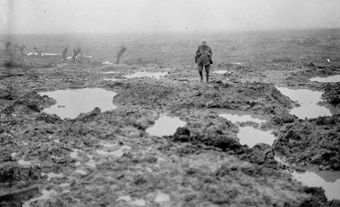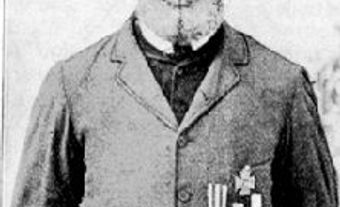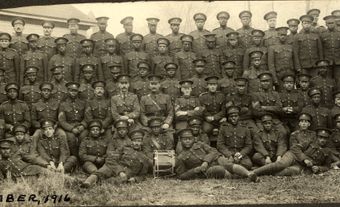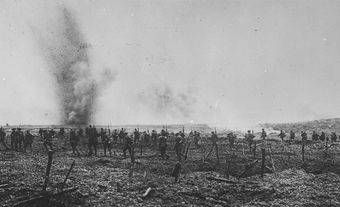Currie Takes Command
Lieutenant General Arthur Currie took command of the Canadian Corps (see Canadian Expeditionary Force) in June 1917, following the Corps' victory at Vimy Ridge. Replacing British General Julian Byng, Currie was the first Canadian put in charge of the Corps, Canada's main fighting force on the Western Front.
In July, Currie received orders from Douglas Haig, commander-in-chief of all British-led forces in western Europe, to capture the French coal-mining city of Lens. Haig hoped this action would divert German attention and military resources away from the major Allied offensive then raging at Passchendaele, in Belgium.
Lens, which lay inside German-occupied territory not far from Vimy Ridge, had suffered terribly in the war. The Canadians were sent to capture a city that lay half in ruins. Currie thought that Hill 70 — an elevation on the outskirts of Lens, so named because it was 70 meters above sea level — was tactically more important. He believed that a traditional, frontal assault on Lens, followed by an Allied occupation of the city, would be futile if the Germans could simply shoot down at the Canadians from the commanding hills. So Currie convinced his superiors, including Haig, to drastically alter the plan of attack, by making Hill 70 the Canadians' main objective.
Currie believed that by capturing the hill he could aggravate the Germans in surrounding positions and provoke them to come out of their dugouts and attack. The Canadians could then kill large numbers of the enemy and drive them out of the area.
Throughout late July and early August, as the Canadians prepared to assault Hill 70, they harassed and distracted the German forces.
Assault on the Hill
Hill 70 was a treeless elevation that dominated Lens. The city itself had been bashed by years of warfare, and German trenches cut through the ruins of the brick homes of the city's coal miners. The ruins offered plenty of cover for the Germans in the city.
The Canadian Corps launched its bid for Hill 70 at 4:25 a.m. on 15 August 1917. The Royal Engineers fired drums of burning oil into the German positions on the hill, along with heavy artillery fire. The Germans of the 7th Infantry Division saw the attack coming and were ready with defensive fire. Still, by 6 a.m., the Canadian infantry — shielded by the smoke screen of the burning oil — had captured several of its early goals.
German resistance stiffened as the Canadians advanced on the hill. The smoke screen drifted away and German machine guns and rifles killed and wounded many attacking Canadians. Attacking Allied soldiers now ran from shell hole to shell hole as they tried to move forward up the hill.
Slowly, the Canadians captured German machine-gun posts and advanced up the hill. Meanwhile, Currie ordered 200 gas bombs fired into German positions south of Lens, as a diversionary tactic during the actual assault on Hill 70.

Counter Attack
The German forces counter attacked before 9 a.m. the next day, but the Allies broke each enemy attempt to reclaim ground. A second wave of afternoon counterattacks was also rebuffed. German infantry troops were met by “fountains of earth sent up by the heavy shells” and “a hail of shrapnel and machine-gun bullets,” according to the history of the German 5th Foot Guard Regiment, and were annihilated.
The Canadians eventually captured the heights of Hill 70, but the cost was high. By the end of only the first day, 1,056 Canadians were dead, 2,432 were wounded and 39 had been taken prisoner. It's not known how many Germans died that day.
Fighting continued around Hill 70 through 18 August, with the Canadian Corps withstanding continued German resistance and counter attacks, in localized fighting that included mustard gas and flamethrowers. After four days of hard combat, the Canadians turned back 21 German counter attacks and held on to their new positions atop Hill 70. About 9,000 Canadians were killed or wounded in the overall battle, while an estimated 25,000 Germans were killed or wounded.
Did you know?
Lancelot Joseph Bertrand was among the thousands of soldiers who died during the Battle for Hill 70. Born in Grenada, Bertrand became one of the first Black volunteers in the CEF when he enlisted in September 1914 at Valcartier. He was a private in the 7th Battalion when he fought at the Second Battle of Ypres (April-May 1915) and the Battle of Festubert (May 1915), where he was wounded. Bertrand was promoted to sergeant in 1916 and then to lieutenant, one of only seven Black officers in the CEF. Lieutenant Bertrand received a Military Cross for his actions in the Battle of Vimy Ridge (April 1917). He was killed on 15 August 1917 during the Battle for Hill 70.
Six Victoria Crosses
The lives of many Canadian soldiers were saved by the work of Private Michael O’Rourke, an Irish-born Canadian stretcher bearer. He received a Victoria Cross for repeatedly running into German fire to rescue wounded Canadians.

Major Okill Massey Learmonth of Québec jumped atop a parapet and hurled hand grenades at the enemy during a German counter attack on 18 Aug. The 23-year-old officer caught German grenades that were thrown at him, and tossed them back at the enemy. Learmonth was wounded and later died, and was posthumously awarded the Victoria Cross.
Another four Canadians received the Victoria Cross for bravery at Hill 70, the British Empire's highest award for military valour: Private Harry Brown, Sergeant Frederick Hobson, Company Sergeant-Major Robert Hill Hanna and Corporal Filip Konowal.
Memory
The fighting at Hill 70, overshadowed by the more famous Canadian battles at Vimy Ridge in April, 1917 and at Passchendaele in the fall of that year, is not as well known to many Canadians. However, some historians argue that Hill 70 was one of Canada's most significant contributions of the First World War, more important even than Vimy Ridge.
“It was altogether the hardest battle in which the Corps has participated,” wrote Currie himself."It was a great and wonderful victory. GHQ [General Headquarters] regard it as one of the finest performances of the war.”
Thanks largely to Currie's tactical skill and prowess, the battle resulted in a German defeat and the diversion of German resources and attention away from the larger Allied campaign underway at the time at Passchendaele. This success, coming after the victory at Vimy, further boosted Canada's sense of pride and nationhood on the world stage. Most importantly, it cemented the reputation of the Canadian Corps as an effective assault force within the larger British army — a reputation the Canadians would prove again and again, under Currie's leadership, through the remainder of 1917 and 1918 as the war eventually wound to an end.
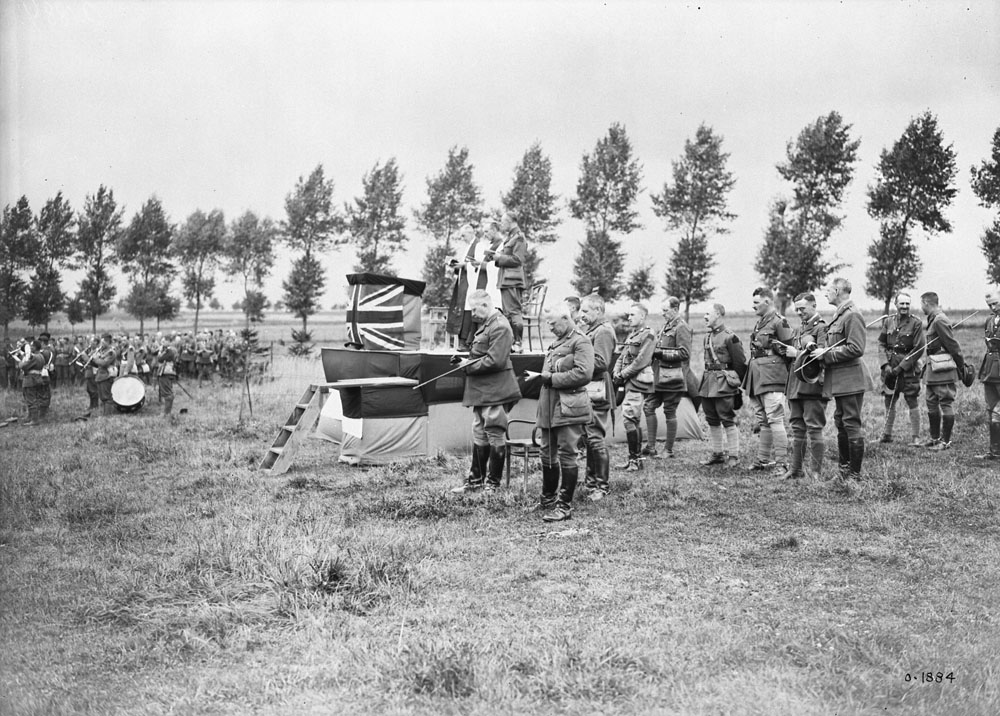
Canada's sacrifices — including the nearly 1,900 Canadian soldiers who died in the battle — are remembered today at the Hill 70 Memorial, and at the Loos British Cemetery outside Lens, France. The names of Canadians who died at Hill 70 with no known graves are also inscribed on the larger memorial at Vimy Ridge.
See also: Evolution of Canada's Shock Troops and Canadian Command During the Great War.

 Share on Facebook
Share on Facebook Share on X
Share on X Share by Email
Share by Email Share on Google Classroom
Share on Google Classroom














